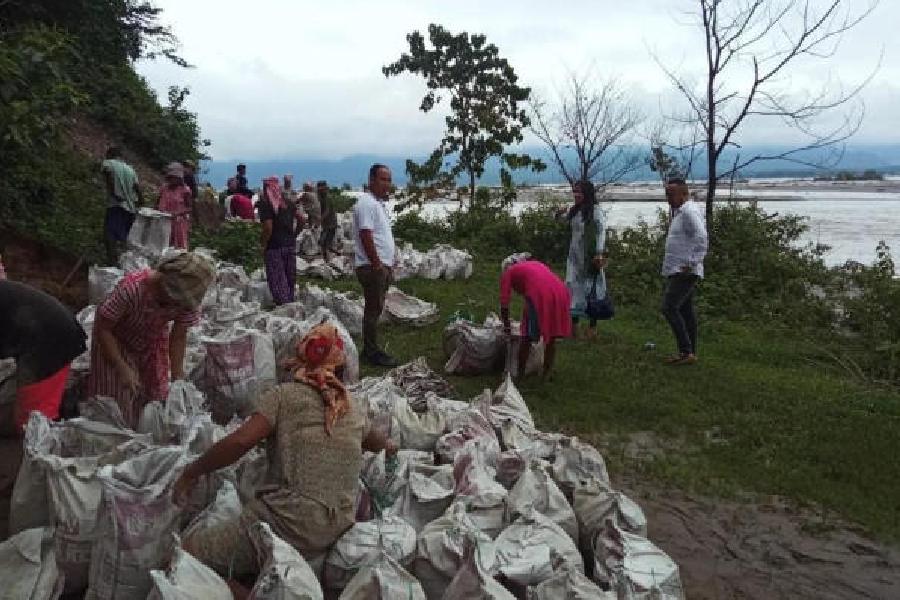Residents in two villages on the left bank of the Teesta and on the outskirts of Siliguri are spending sleepless nights as water level of the mighty river is steadily increasing amid monsoonal downpour in its catchment areas, especially upstream.
Around 1,600 people at Chamakdangi and Laltong – two forest villages on the fringes of Mahananda Wildlife Sanctuary, which are around 25km from Siliguri, are fearful that if water levels continue to increase, the river will inundate both hamlets.
The villages are located under Dabgram-I panchayat of Jalpaiguri district. The people here depend on agriculture and poultry farming.
Residents, living in the areas since the 1970s, have requested the administration and the local rural body to shift them to a safer place. However, there has been no development so far.
In Chamakdangi, around 50 per cent of a 70-metre-long protection spur (a nose wall that diverts the river’s flow and stops it from getting close to the village) has been washed away by the Teesta in the past fortnight.
“The swollen waters of the Teesta have damaged major portions of the spur. Now, we are spending sleepless nights as there is fear that the river will flood the village any moment,” said Champay Mukhia, a resident of Chamakdangi.
Laltong faces a similar situation. The Teesta is flowing almost at the same level as the village. “If the water level increases further, it will enter our village. We are keeping our fingers crossed,” said Gele Sherpa, a resident of Laltong
Sources in the Siliguri Jalpaiguri Development Authority (SJDA) and the state irrigation department said they had visited villages with members of the local panchayat to take stock of the situation.
“We have inspected the area. Some temporary measures have been taken to prevent water from entering the villages,” said Gautam Goswami, a member of the SJDA.
In Alipurduar, where it rained around 240mm during the past 24 hours (till 8.30am on Sunday), the swollen Buri Torsha river swept away a diversion on Saturday night.
As a result, direct connectivity between Alipurduar and Falakata has snapped. People have to travel an additional 18km via Pundibari of Cooch Behar to reach Alipurduar from Falakata and vice-versa.
The monsoonal downpour has flooded several tea gardens in the district. Also, the Kaljani river, which skirts Alipurduar town, has spilled onto its banks and inundated at least seven municipal wards in the town.
“People living in low-lying areas have been alerted. We are keeping a close watch on the situation,” said R. Vimala, the district magistrate of Alipurduar.
Rainfall has caused heavy damage to the Central Dooars tea estate in Kalchini block. Shantanu Basu, the manager of the garden owned by McLeod Russel India Limited, has sent a letter to the district magistrate, seeking immediate help.
He said that the Kalijhora, the Pana and the Basra, three rivers that originate from Bhutan and flow close to the garden, have swelled and flooded around 80 per cent of the garden’s plantations.
“The rivers have also flooded workers’ quarters. We have lost around 10 hectares of plantations in the flood. Drinking water supply has been disrupted. Further, the main road that connects the garden with Jaigaon and Kalchini is damaged and we face problems bringing essential items and dispatching tea,” said Basu.
There are 2,500 workers in the garden. Around 25,000 persons — mostly families of tea workers — live on the tea estate. “A culvert is badly damaged and children can’t go to school. If a patient has to be shifted elsewhere from the garden, we can’t even reach an ambulance,” he added.
Sources in the regional Met office in Calcutta said on Sunday that as the southwest monsoon was active in north Bengal, a red alert was already issued in the districts of Alipurduar, Jalpaiguri and Cooch Behar for the next couple of days.
“There is a forecast of 70mm to 200mm of rainfall. In fact, it might even rain above 200mm in some places,” said a weather expert.











